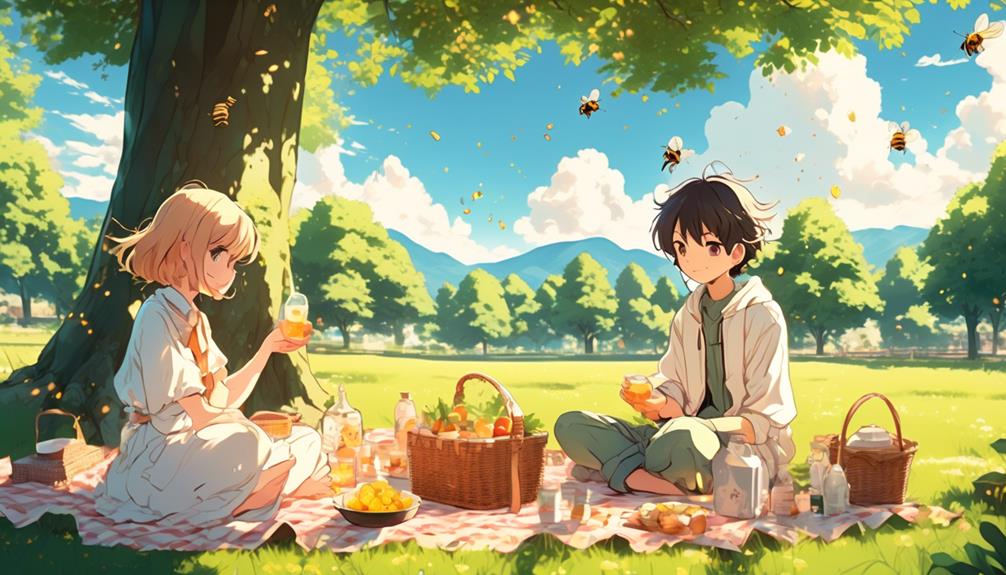Master the art of a bee-free outdoor meal with our top strategies for deterring these pesky picnic crashers.

How to Deter Bees When Eating Outside?
Did you know that bees can detect food sources up to five miles away? That's an impressive feat, but it also means your outdoor feast can quickly become a bee's banquet too.
There's nothing like enjoying a summer meal outside, only to have it interrupted by a swarm of these uninvited guests.
You're probably wondering, is there anything you can do to keep these pesky insects at bay? Let's just say, you might want to hold off on planning that next picnic until you've explored some tried and true strategies for deterring bees.
Key Takeaways
- Bees are attracted to food, water, and shelter, so it is important to minimize these attractants when eating outside.
- Certain foods like cucumbers, garlic, mint, and cloves can act as natural bee repellents when incorporated into meals.
- Planting mint, lemongrass, geranium, or citronella near the dining area can deter bees, as well as using homemade bee deterrent sprays made with mint essential oil, dish soap, and water.
- When setting up for a bee-free picnic, choose a location away from trash bins, flowering plants, and stagnant water, store food in airtight containers, wear light-colored and unscented clothing, and clean up immediately after eating.
Understanding Bee Attraction

Before you can effectively deter bees, you've got to understand what attracts them in the first place. The primary lures are related to their basic survival needs: food, water, and shelter. And, unfortunately, your outdoor dining setting might just be providing all three.
Bees are primarily drawn to sugary substances, which they source from nectar. So, your sweet drinks, fruits, and sugary foods are like bee magnets. They're also attracted to certain colors, particularly bright ones like yellow and blue. If you're wearing these colors, you're inadvertently inviting them closer.
Water, too, is a big attractor. Bees need it to survive, just like us. If there's an open water source nearby, like a pool, pond, or even a glass of water, it's like rolling out the red carpet for them.
Lastly, potential nesting sites are bee attractors. Hollowed wood, garden debris, and even the ground can be potential homes for certain species.
Understanding these attractors is key. You can't hope to deter bees without first knowing what's drawing them in. This knowledge provides a solid foundation for efficient and effective bee deterrence strategies.
Choosing Bee-Repelling Foods

In the quest to deter bees from your outdoor dining experience, integrating bee-repelling foods into your menu can be a highly effective strategy. Certain foods and spices have been scientifically proven to repel bees and can be easily incorporated into delicious dishes. This method not only wards off these buzzing invaders, but also enhances the overall flavor of your meals.
Consider the following table of bee-repelling foods and spices:
Food | Reason | Usage |
|---|---|---|
Cucumber | Bees dislike the acidic property of cucumbers. | Slice them for salads or sandwiches. |
Garlic | The strong odor is off-putting to bees. | Use it in marinades or salad dressings. |
Mint | Its potent smell is a bee deterrent. | Add fresh leaves to drinks or desserts. |
Cloves | Bees find the smell of cloves repelling. | Sprinkle ground cloves in sauces or on meats. |
Natural Bee Deterrents

You can also deploy natural bee deterrents, such as certain plants and homemade sprays, that effectively keep these buzzing creatures at bay while enjoying your outdoor meal. For instance, bees tend to avoid mint, so try planting spearmint or peppermint near your outdoor dining area. You can also make a homemade, all-natural bee deterrent spray using essential oils from these plants.
In scientific terms, bees have a strong olfactory sense that they use to locate food sources. The strong smell of peppermint disrupts this sense, making it difficult for them to locate your food. Similarly, the scent of other plants like lemongrass, geranium, and citronella can also act as effective deterrents.
For the homemade spray, you'll need about ten drops of mint essential oil, one teaspoon of liquid dish soap, and two cups of water. Mix these together in a spray bottle and lightly mist your eating area before your meal. The dish soap helps the mixture adhere to surfaces, increasing its effectiveness.
It's important to apply the spray frequently, especially after rain or heavy dew, because the natural ingredients can easily be washed away. This method isn't only effective but also safe for the environment and your family.
DIY Bee Repellent Sprays

Building on the idea of natural deterrents, let's now explore how you can craft your own DIY bee repellent sprays using readily available household items.
First, consider a vinegar-based spray. Vinegar's strong odor disrupts bees' sense of smell, thus deterring them. Mix equal parts water and white or apple cider vinegar in a spray bottle, then add a few drops of dish soap. The soap traps the vinegar's scent, increasing the deterrent effect.
A second effective repellent uses essential oils. Bees detest the scent of peppermint and citrus. Combine 10-15 drops of these oils with a cup of water and a teaspoon of dish soap. This blend won't only repel bees but also provide a pleasant aroma for your outdoor gathering.
Lastly, a spicy spray can be made by steeping two small, chopped hot peppers in a cup of boiling water. Once cooled, strain the mixture and add it to a spray bottle. The capsaicin in the peppers is an effective bee deterrent.
Bee-Free Picnic Setup Tips

Ensuring a bee-free picnic requires strategic planning and a keen understanding of these insects' behaviors and preferences. Bees are attracted to sweet scents, so avoid wearing perfumes or lotions that could lure them. Choose unscented hygiene products when you're planning to dine outdoors.
Consider your picnic food carefully. Bees are attracted to sugary foods and drinks, so opt for less sweet options. Seal food containers tightly and don't leave drinks uncovered.
Here are some strategies for a bee-free picnic setup:
Strategy | Explanation | Result |
|---|---|---|
Location | Choose picnic sites away from trash bins, flowering plants, and stagnant water, which are bee attractants. | Reduced chance of bee encounters. |
Food storage | Store food and drinks in airtight containers. Open them only when needed. | Less bee-attracting aromas. |
Dressing | Wear light-colored, unscented clothes. Bees are attracted to dark colors and sweet scents. | Decreased visibility to bees. |
Cleanliness | Clean up immediately after eating. Don't leave any food or drink residues. | Minimized bee attractants. |
Wardrobe Considerations for Outdoor Dining

When choosing your attire for outdoor dining, it's crucial to consider the potential appeal to bees. These insects are visually attracted to bright floral patterns and dark colors, which they associate with their natural food sources. Therefore, it's wise to opt for clothing in light, solid colors to lessen your attractiveness to bees.
In addition, avoid wearing shiny jewelry or accessories. Bees are attracted to shiny objects as they can mistake them for dew or other sources of water.
Furthermore, the use of perfume, cologne or scented body products can attract bees due to their floral or sweet odors, mimicking the aroma of certain flowers or fruits they're drawn to.
Fabric type can also be influential in deterring bees. Opt for smooth-textured fabrics, as bees are less likely to land on these compared to rough surfaces, which they find more grip-friendly.
Frequently Asked Questions
What Is the Behavior of Bees When They Are Threatened or Disturbed?
When you threaten or disturb bees, they'll likely respond defensively. Usually, they'll buzz more loudly, fly erratically and may even sting to protect their colony. Bees don't usually attack unless they feel their hive is under threat.
It's also important to note that once a bee stings, it dies, so it's a last resort for them. Understanding this behavior can help you avoid creating a situation where bees feel threatened.
How Can I Treat a Bee Sting if Someone Gets Stung During an Outdoor Meal?
If you're stung by a bee during an outdoor meal, first remove the stinger by scraping it out with a credit card. Don't squeeze it or you'll release more venom.
Clean the area with soap and water, then apply a cold pack to reduce swelling. Over-the-counter pain relievers and antihistamines can help with pain and itching.
If there's severe swelling, difficulty breathing or dizziness, seek medical help immediately as it could be an allergic reaction.
Are There Specific Weather Conditions That Can Deter Bees From Coming Near My Outdoor Dining Area?
Yes, weather conditions can indeed impact bee activity.
Bees don't like cold, wind, or rain. When it's chilly, windy or rainy, they're less likely to be out and about.
So, if you're planning an outdoor meal, try to do so in these conditions. However, remember that it's not a guaranteed deterrent.
Bees are resilient creatures and may still venture out if they're particularly determined or if their hive is nearby.
How Effective Are Professional Bee Repellent Products Compared to DIY Solutions?
Professional bee repellents often offer a more potent and long-lasting solution than DIY methods. They're scientifically formulated to target specific bee behaviors and disrupt their scent trails.
However, you'll find DIY solutions can still be effective for short durations and smaller areas. It's important to remember, though, that effectiveness can vary based on factors like bee species, weather, and the specific product or DIY solution used.
What Should Be Done if a Large Swarm of Bees Invades My Outdoor Dining Space?
If you're faced with a large swarm of bees invading your outdoor dining space, don't panic. Stay calm and slowly move away. Don't swat at them, as this can provoke them. Instead, consider using smoke, as bees dislike it. It can help disperse them.
If the swarm doesn't leave, call a professional pest control service. It's not advisable to handle a large swarm on your own due to the risk of stings.
Conclusion
In conclusion, understanding what attracts bees to your outdoor dining space is crucial. Opt for bee-repelling foods and apply natural deterrents or DIY repellent sprays.
Setting up a bee-free picnic area and considering your wardrobe can also help. Remember, it's not just about keeping bees away, but also respecting their vital role in our ecosystem.
With these tips in mind, you can enjoy your al fresco meals in peace.



